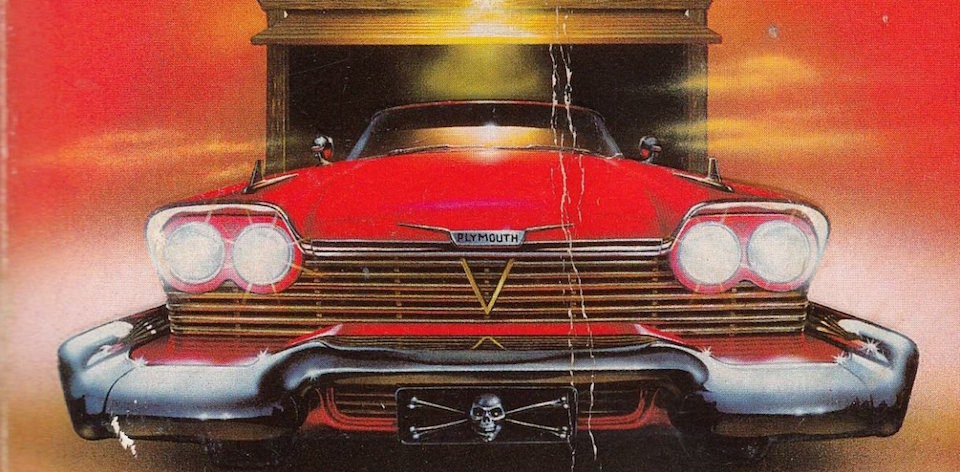Welcome back to the feature column that explores Stephen King’s books in the order they were published! (Sort of!) Here’s the one about the demon car that made Constant Readers feel like backseat drivers. Roadwork warning: SPOILERS AHEAD NEXT FIVE MILES.
Whenever I happen to tell someone that I’m reading yet another Stephen King book, non-fans typically respond in the same way. A knowing eye-roll signifies a ready-made assumption about genre books, caring little for how easily some of them could slip into the ‘literature’ section without much fuss. Yet CHRISTINE is a different beast entirely, one that pushes the limits of fandom. For a book about a car, it’s wholly on rails.
At this point in King’s bibliography, he’s delivered some frightfully clever spins on psychic children (Carrie, The Shining, Firestarter), vampires (‘Salem’s Lot), devil dogs (Cujo) along with several stabs at epic fantasy (The Stand, The Gunslinger, The Eyes of the Dragon). After sharing his non-horror side with the novella collection Different Seasons, CHRISTINE was the first of three books released in 1983 – and arguably a sign that the writer was stretching himself a little thin.
On paper (which is where most books of the era tended to be written), it’s got all the elements of a classic. Set in the summer of 1978, best friends Dennis Guilder and Arnold “Arnie” Cunningham spot a rusting 1958 Plymouth Fury. After some wrangling with owner Roland D. LeBay – a grizzled war vet who calls the car ‘Christine’ – Arnie purchases the car and begins restoring it. His hobby turns to obsession, as Dennis, friends and family think that Arnie is neglecting his life. Soon it becomes obvious that not only is the car changing, but Arnie is as well.

Yet despite this straightforward setup, to say that the book is structurally messy is generous. It starts off with the first-person perspective of Dennis, perhaps the first time King had employed that narrative approach outside of a Richard Bachman novel (see: Rage) and a handful of short stories. Bachman is a good comparative touchpoint, as there’s a narrative distance from the start, almost as if King was going through the motions and taking himself out of the equation.
Dennis is a bit of a wet narrator too, reacting rather than acting his way into the story. In fact, for a book about a killer car, CHRISTINE spends a lot of time spinning its wheels. After Dennis has a football accident a little shy of the halfway mark, King abruptly shifts to a third-person perspective where he floats between Arnie and his beautiful new girlfriend Leigh. In a 2001 interview, King spoke about this left turn as an attempt to get out of a narrative jam that almost killed the book entirely:
“For a long time, I tried to narrate that second part in terms of what he was hearing, hearsay evidence, almost like depositions. But that didn’t work…I tried to leave enough clues, so that when the reader comes out of it he’ll feel that it’s almost like Dennis pulling a Truman Capote. It’s almost like a non-fiction novel. I think that it’s still a first-person narration, and if you read that second part over, you’ll see it. It’s just masked, like reportage.”
Was this a lack of self-editing or too much commercial pressure to leave it on the shelf? After all, King still had two more on the pile ready to go in 1983, the superb musing on grief in Pet Sematary and the shorter Cycle of the Werewolf.
Even with the broader narrative perspective, the book lacks any immediacy to the drama or characters. Almost everyone except for Arnie knows there is something wrong with the car, and Arnie is certainly not someone we can care about. The ‘other’ female love interest (other than Christine) is Leigh, who serves as a nothing more than a story object for both male leads. When we return to Dennis for the (somewhat predictable) blockbuster conclusion, and get a recap of almost everything in the middle section, we are told that Leigh “managed to look both practical and sexy.” Talk about a Mary Sue, eh?
The other issue, of course, is the general acceptance of the notion of a demon car. I’m willing to accept pretty much any scenario, but most sentient cars (not named Herbie) tend to leave me cold. It’s probably why I never really got into the adventures of Lightning McQueen in Disney’s Cars series. (Sidebar: if there are no humans, why do they have doors?!?) It’s not even King’s first foray into manic motors, with his superior Trucks short story published a decade earlier in Cavalier magazine (and reprinted in the Night Shift collection).
Like the eponymous ’58 Plymouth, the bones of this beast are solid but it takes a fair bit of love to see the shiny treasure underneath. “I thought it would be a funny short story-a kind of American Graffiti,” King says of the inspiration. “Instead, a fairly long novel came out, a supernatural tale about girlfriends, boyfriends, and Christine.” Spawning a John Carpenter movie only months after the release of this book, CHRISTINE has become an iconic emblem for evil cars everywhere. Yet for Constant Readers, this may not be the joy ride you were looking for.
We’re back on track now! Next, we howl at the moon with Cycle of the Werewolf! Hey, while you’re here, go check out Batrock.net, where my buddy Alex Doenau is running through Stephen King with me.





